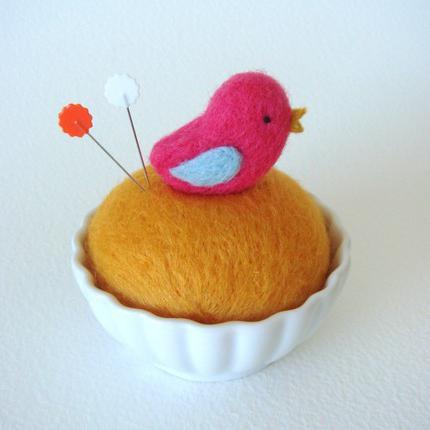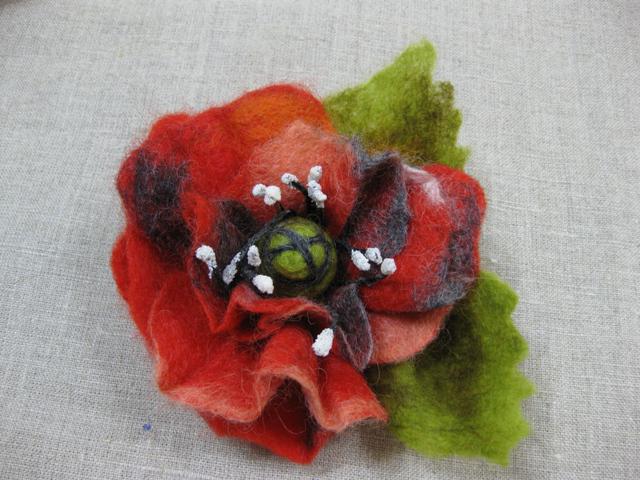The ancient art of felting from wool in recent years has become a fairly common hobby among skilled needlewomen. This technique is also called felting or banding, and with its help you can make a huge variety of cute gizmos: jewelry, toys, as well as clothing, jewelry and even shoes. Perhaps this is the easiest lesson that a beginner needlewoman can easily handle. The felting technique involves two types of felting: wet and dry. For the first, certain skills are needed, and the second is suitable for people with any level of training.
What is needed for felting wool?
To master felting with your own hands, you need to stock up on the necessary materials and tools. The main thing that comes in handy is natural wool and special needles. Material of any color and shade can be bought at a needlework store; needles of different thicknesses are also sold there. To create flat figures you will need silicone molds, and for bulk products - a synthetic winterizer, so as not to waste precious woolen threads, which significantly lose volume after felting. For convenience, prepare a sponge so as not to prick your fingers and the surface of the table. Now on sale you can find ready-made sets for felting, especially useful for beginners.
What is the difference between needles?
Those who master the technique of do-it-yourself felting should know that the process of felting is carried out with metal needles of different thicknesses with a bend at one end to make it comfortable to hold, and notches for tangling the fibers at the other.
The most voluminous ones are used at the initial stage of creating crafts to give the initial shape, then they are replaced with thinner needles to complete the process. To give the final shape, add small strokes and the necessary details take the thinnest needle. At the final stage, a thick awl will leave noticeable holes in the puncture sites. To be fully equipped, starting the felting technique, it is advisable for beginners to stock up not with one needle, but several, since when felting wool in a uniform or in a bad jerk, they often break. To increase the speed of creating jewelry it is recommended to use several needles at the same time, for this there are special holders.
Felting technique
A technique such as felting (this is especially true for beginners) allows you to create soft beads, toys and flowers, that is, volumetric elements, on the first attempt. On the voluminous sponge put the amount of wool fibers that exceeds the size of the final version, since the material will sit on a third. The same fibers can be placed in a silicone mold, for inexperienced users it is desirable without a bottom (so as not to break the needle and not puncture the hands). To create a bead, it is enough to roll up the wool in the form of a ball.

Now you need to pick up a thick needle and stick it into the lump, each time turning a little. The notches at the end will cling to the fibers, they will become tangled and decrease in volume, and the figure will acquire a dense structure. The needle must be operated very carefully, not beat on a grand scale, and not keep the workpiece on weight. Also, it is lowered perpendicular to the felting plane, turning the publication itself. When the figure takes shape, the needle is replaced with a thinner one.
How to create compound crafts
If you have already created a simple decor element using the felting technique, you can proceed to create more complex designs that consist of several parts. For example, to create a nesting doll you will need two balls that are dumped together and wrapped with a layer of wool of the same color. Then a thin needle rolls on the face, clothes and other details and jewelry. To make a large toy in the style of felting, for beginners and experienced needlewomen it is better to use a synthetic winterizer as a basis. He is also shaped with a large needle, and already a layer of wool is piled on it, which is interwoven with the main one, becoming an inseparable product. The advantage of dry felting is that if it fails, the appearance of bumps does not have to be redone, just add the right amount of fibers and roll them with a thin needle to the main product.
The technique of wet felting
Felting using a warm soapy solution that turns wool into felt is a completely different matter. For felting you will need wool, a wooden rolling pin, thick cellophane and nylon fabric. So, let's start the wet felting technique. The master class for beginners consists of the following steps:
- A soap solution is created: one bar of soap is rubbed on a grater and filled with hot water (2 l). The mixture is thoroughly mixed until the soap dissolves and infused until thickened (about 2 hours). Although you can use liquid soap from the store.
- On the table there is a litter (preferably a speckled polyethylene film), on which wool is laid in layers. First the background, then, in accordance with the scheme, a specific pattern of pieces. Each subsequent layer is laid perpendicular to the previous one. In terms of thickness, the workpiece should be 3-4 times thicker than the expected web, and the fibers are evenly distributed over the entire surface.
- The finished "picture" is sprayed with water from a spray bottle to fix the pattern, cover with a capron and moisten with a soap solution. They pass along it with their hands; for impregnation, they are rolled with a rolling pin with great accuracy so as not to displace the pattern. Excess liquid is blotted with a towel.
- Getting started the process of felting: rub the canvas with his hands in various directions

In the technique of wet felting for beginners, it is easy to make a scarf, and experienced craftsmen make mittens, slippers, and even bags. It is believed that this is a more complex and time-consuming process, and it is worth starting, having mastered the dry method.
The benefits of felting
Compared to other techniques and hobbies, felting for beginners has several obvious advantages:
- No skills and large work space required;
- while felting, you can chat with friends or watch movies;
- calms nerves, acting as a stress therapy session;
- brings variety to everyday activities.
And finished woolen products will please relatives and friends, give them a piece of your warmth.